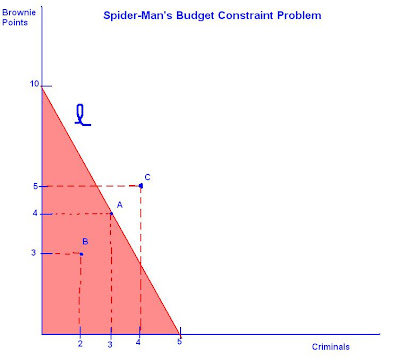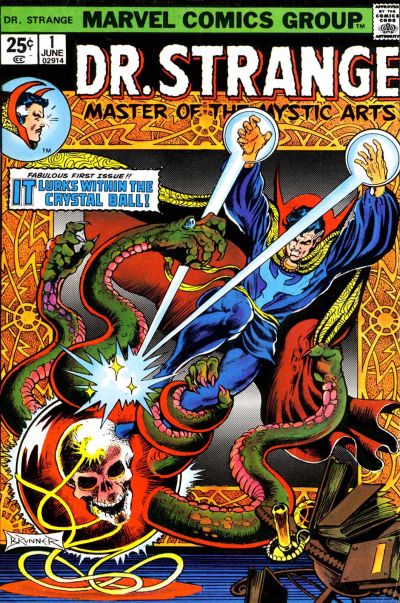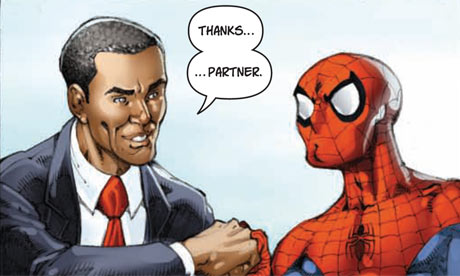 Irredeemable #7 by Mark Waid and Peter Krause (2009)
Irredeemable #7 by Mark Waid and Peter Krause (2009)
Here's one thing that distinguishes the universe of Mark Waid's
Irredeemable from the DC Universe: the Plutonian (the Superman equivalent of this world) and his squad of Justice-League-like superheroes, the Paradigm, don't seem to have a very optimistic view of human nature. They equate giving humans access to alien technology to handing out hand grenades to orangutans. Earlier, the Plutonian referred to Earth as an ant farm. It seems that, unlike Superman, who possesses an almost naively positive view of humans, the Plutonian has established himself as a de facto Hobbesian Leviathan. He is there to stop humans from destroying themselves--to aid in the escape from what he sees is their natural state of war, jealousy and corruption.
That being said, the two do have something in common. Namely, given all of the technology that these superheroes have access to on a daily basis (remember, Superman frequently travels through space
and time), Earth remains at relatively a similar level to how it is in the real world. Why is this? What exactly do superheroes fear will happen if the humans were given access to these marvels in science and magic? In a
previous post, we had discussed the harms of keeping this information hidden:
Ever wonder why people in comics aren't teleporting to work, watching TV through a personal projection device while walking down the street, or attending seminars hosted by an android via group-telepathy?
Instead, the worlds in our favorite comics still have potholes, poverty, and petroleum-powered cars. In fact, aside from the occasional reality-bending crisis involving metahumans, it’s hard to distinguish our world from theirs in terms of technological progress or standards of living. This begs the question of what happens to all the alien wreckage after the Justice League fends off another alien invasion, or to the abandoned spaceships when interplanetary thugs with a grudge against Superman land on Earth. Do men in black immediately cart them off to secret government facilities and weaponize them? If so, then these governments are doing a great disservice to their people. The fastest way to achieve economic growth is through the free and unfettered dissemination of knowledge. Governments should encourage the private sector to develop commercial uses for all the space junk that winds up on earth, thereby simultaneously increasing both the capital stock and total factor productivity. [...] And it’s not just the responsibility of the governments, but also of the superheroes.
Indeed, if it is the case that the superheroes of the DCU are keeping this technology from the humans intentionally, then they are setting the race at a disadvantage. And by the way this does seem to be what they are doing--one needs to look no further than the
gadgets available in the Justice League watchtower to know that there is a gap between space and Earth. There is no telling how much Earthlings could potentially benefit from both the physical and human capital available at their disposal. In the Marvel Universe, for example,
mutants could be put to work in ways that don't involve them living somewhere out on the San Francisco Bay and having their resumes consist exclusively of the phrase "Fight Magneto."

So then, what's the deal guys? Well, what the major superheroes fear is that humans will either intentionally put this technology to inappropriate uses or that their lack of sophistication and experience would inevitably lead to the mishandling of such overwhelming power. This is what the Plutonian and the Paradigm explicitly state (and what I imagine Superman and the JLA think too).
But, is this really a legitimate concern? It turns out that in this particular instance, it was justified. Eventually the Plutonian caved to the pressures of the scientific community and handed over a tiny device found on an alien ship. Here was the devastating result:

Woops. Now we can see why the Plutonian turned evil. This would be enough to make anyone doubt humanity's potential. Even the purest of superheroes might decide that we simply aren't worth saving.
But it's really not humanity's fault. At least not entirely.
First of all, I think it takes a pretty pessimistic person--superhero or not--to hide possibly life-saving technology from others. The fact that this sort of act was fully supported by the world's most noble protectors is highly suggestive of their real views on humans. And I'm not just talking about the Paradigm here. Despite all his preaching of believing in the goodness of man, Superman was still in the company of those who fended off the alien invasion, scavenged the alien ships for useful technology, threw that technology in a trophy room aboard the Justice League watchtower, and did not even alert the people of Earth to its existence. Even if Supes would justify this by claiming that humans would be better protected with such materials in the hands of the League, it still demonstrates a fundamental lack of trust. And if deep down the Superheroes don't trust the humans, how could the humans trust the superheroes?
Of course this does not mean that Superman and the Plutonian are wrong, nor does it justify humans using these devices haphazardly. So if withholding these alien goody bags is not the answer and if the Plutonian has such a profound lack of trust in the people of Earth such that he fears turning over the tech. freely, is there anything else that can be done? Well, why not donate, but heavily regulate the research and development projects?
With the exception of Batman and possibly a few others, it is generally known that no Earthling is as smart as Superman. Given a piece of technology, Superman and the League could most likely figure out precisely what it can and should be used for. Why not have a look at it themselves first and then donate? If there is an alien device that has the potential to conserve water more efficiently, why not use it to built a really awesome toilet for the humans?
OK, granted many of the bigger superheroes have things to do--guy jumping off a roof here, fourth-world deity trying to enslave humanity there. But not all of them, right? And certainly not
all the time. The Justice League has lots and lots of members. I'm sure it can afford to delegate a task force of some of its scientists to working with human researchers at developing proper uses for this technology.
Also, superheroes regulate everything already. They counsel world leaders in making policy choices, they get called in to speak in front of the UN Security Council, they help set international public health initiatives, the list goes on.
This seems like something that is not only feasible, but even responsible. Moreso anyway that simply continuing to foster insecurity and suspicion among the public. And perhaps it would further cement humanity's trust in the superhero community, to the extent that your Joe Everyman would cease being so
easily persuaded by clever villains to start hating on Superman and Batman.
The Plutonian did eventually submit, but it was for all the wrong reasons. It was not for an interest in the advancement of society or in an attempt to usher in an era of harmony and cooperation. It was, instead, to mitigate some bad press towards him. It was primarily selfish. With some regulation and a little bit more effort, this whole thing might have been averted. Sorry planet.

















































